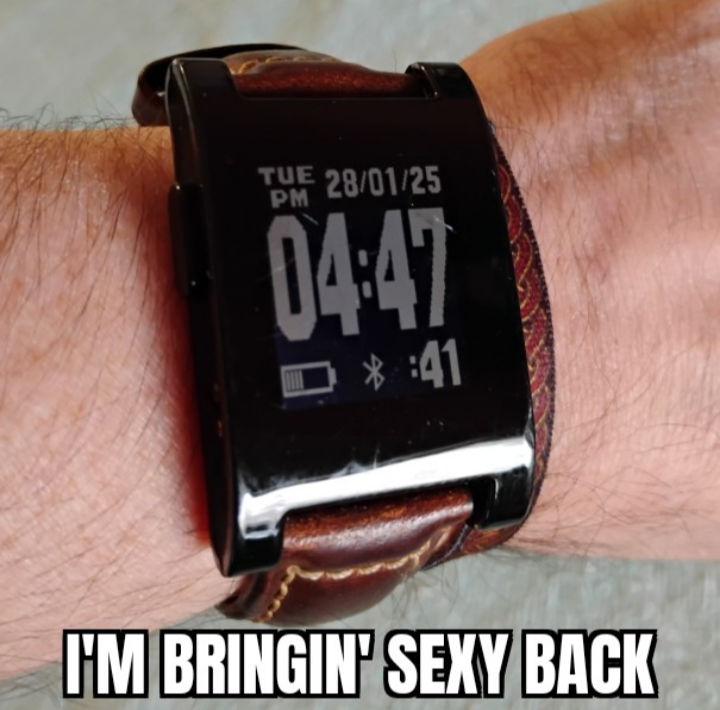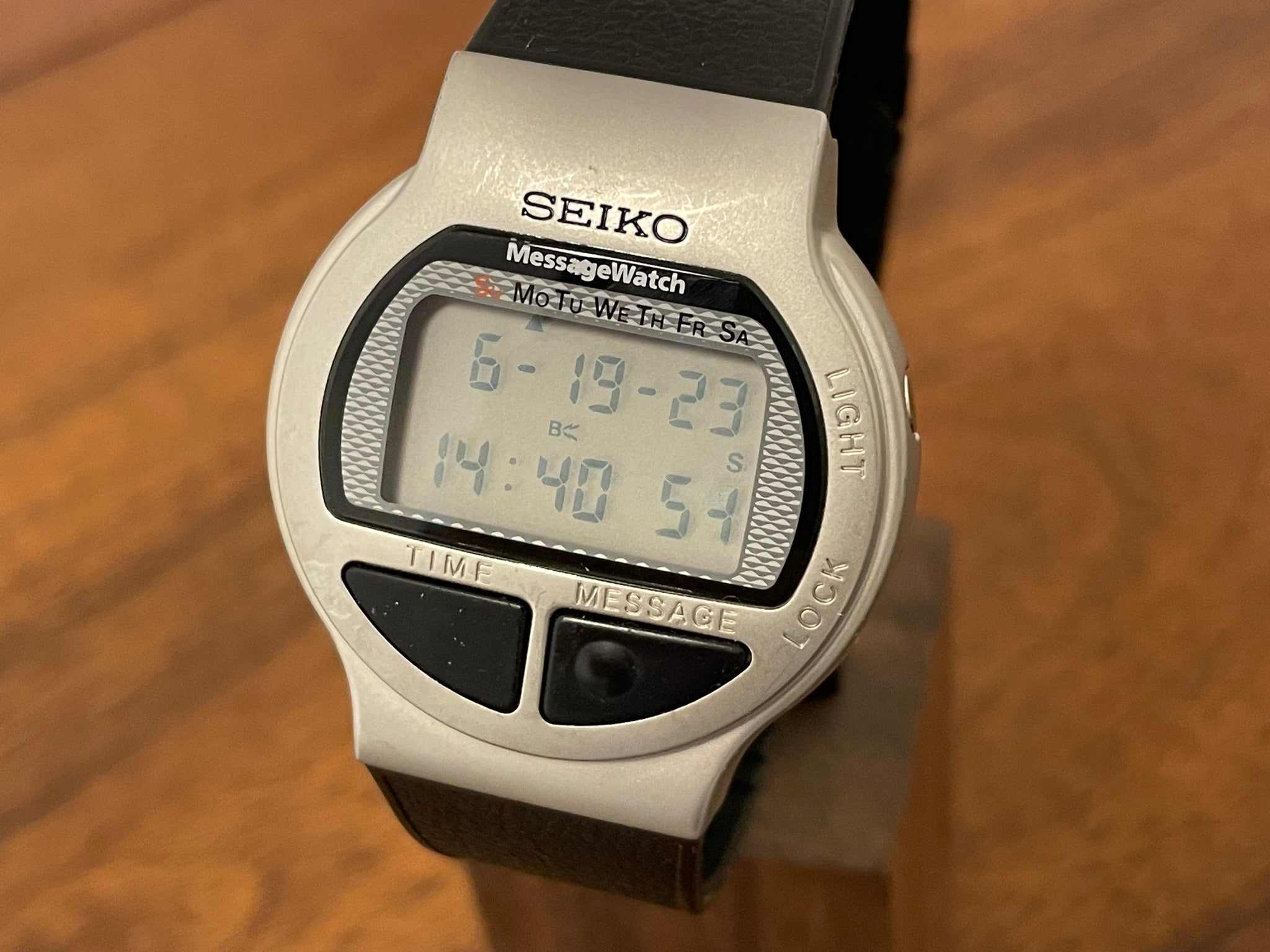Pebble Pride
Tag: #gadgets
Author's note: to celebrate the recent announcement about Bringing Pebble Back, I decided to yank this half-written article out of the bin and finished the danged thing. I typically avoid bandwagons, but I am definitely going to let myself get hype for this one!

I live my life by a lot of soft rules to cope with Anxiety that might seem restrictive to an observer. Oddly, some of those rules have morphed into passions, such as keeping old tech alive because it tends to feel less invasive and more stable than modern alternatives. This is why I still sport an OG Pebble Smartwatch. It's what all smartwatches should have been and as far as I can tell, nobody has gotten it right since.
The Pebble Technology Corporation was a short-lived tech company that, to my tired eyes, had a lot of parallels and lasting impact on the industry that are similar to Otrona's brief influence on the luggable computer market in the early 1980's. Both companies came out of the gate with a terrific flagship product, setting the stage for a market that was arguably nebulous up to that point, had their moment in the sun, then shuttered the windows and faded into general obscurity for all but a perpetually honking gaggle of loyal fans.
Smartwatches certainly existed before Pebble came along, but what we needed was a mobile accessory that played nice with both iOS and Android, rather than being part of a closed ecosystem. The Pebble satisfied this with style and grace. To me, that makes it the first real cross-platform compatible smartwatch that anyone could integrate into their personal tech. It is possible that there were other cross-platform smartwatches prior, but if they existed, they made no waves, so I missed them. If you know of one, email me, since this article kinda turned into another ridiculous rabbit hole (again!) that I might expand on later. No joke, there were *a lot* of crazy interesting smartwatches out there at the dawn of the smartphone era.
Here's a probably-too-brief Pebble history:
- 2012 - Pebble does one of the most successful Kickstarters of the time, setting hopes remarkably high.
- 2013 - Pebble ships the original Pebble smartwatch...much to the surprise of backers who got burned by other big Kickstarters during this era. The SDK was also released, allowing the community to start building apps for the Pebble.
- 2015 - Pebble Time model gets a go, ushering in the 2nd Generation Pebble devices and hardware improvements.
- 2016 - The Pebble 2 launches as, perhaps confusingly, the flagship for their 3rd Generation devices.
- 2016 - Six months later, Pebble announces that it can't pay the bills, sells its talent and software to Fitbit, leaving the hardware to rot...until the Rebble community rallied mere days after the announcement. To this day, I still have functioning Pebble smartwatches because of them.
This history is meaningful because Pebble, in my experience, set the tone for the entire smartwatch market moving forward and we have some brilliant smartwatches ticking away out there as a result. I'm also not necessarily going to blame Apple for their part in effectively killing Pebble with their high-end watch, but the launch of the Apple Watch definitely stunted Pebble's market share by, well, a lot. I could argue that Pebble had the engineers who could have developed a competitive device, but that would have gone against what I consider the Pebble ethos; to make a simple and polite accessory for your smartphone. This is contrary to manufacturers like Apple or Samsung, both wanting complete control over how you use their products, not the other way around. This is actually the biggest reason why I never got on the Apple train specifically, since much of their tech is otherwise really nice. I never got on the Samsung train, either, but that has more to do with nausea and primal loathing, requiring a whole different article to explain why I hate them so much. The takeaway here is that Pebble was selling an adaptable device, where Apple and the like were selling a lifestyle, which is an important distinction to remember when choosing tech products.
The surprisingly interesting evolution of smartwatches goes back to the early 1980's where Seiko dominated with devices like the RC-1000 and TV Watch. No, I'm not going to be like those numpty tech bloggers, beating that cheap toy drum about the "first" smartwatch being the Plus Four Wristlet. It's not a watch. It wasn't a watch in 1927, either. It doesn't tell time or offer an alarm, or even tell you what day it is. It's just a rolled-up map for your wrist, in no way qualifying it as a "smartwatch." That's it. You look dumb when you based your article on its existence. Get over it. End rant.
Anyway.
I barely paid any attention to smartwatches up until about the 2010's, but Seiko apparently had some horology bangers over the years, which I am now actively seeking for my collection. The one that stands out was the MessageWatch (aka the Receptor) in the mid-1990's, which only worked in certain cities, basically an FM radio pager crammed into a wristwatch. It could receive messages with some obvious limitations and was ultimately killed by Y2K, which was an actual looming problem to many systems back in the day, but not the possibly-world-ending event some media made it out to be back then. In any case, this watch made a splash in the Pool of Technological Convergence that all devices seem to lumber toward, escaping the audacity of rugged individual purpose to bathe in its milky waters, emerging as something redefined in the future. Copyrightious made a lovely ode to this watch, keeping in mind its message restrictions (linked below) and while relatively few wrists wore it, the impact was clear; a "watch" could do more than tell time. By then, we'd already famously established that a watch could also be a calculator or serve as a tiny database for phone numbers. Now it could communicate wirelessly with other systems!

There are too many other awesome pre-Pebble watches to list here, probably enough models to fill an entire book, what with Fossil and Microsoft getting in on the game in the early 2000's. Sony's own creatively named 'Smartwatch' looks like the blueprint for the Apple Watch, but only worked with their Xperia phones. Each successive smartwatch model had restrictions that trapped it in an artificially small market, but also celebrated advancements that edged us closer to the smartwatches we know today. Darwin would have been proud.
Enter Pebble. Eschewing the retina-baking XLED screens for something easy on the peepers because really, nobody enjoys involuntary laser eye surgery. The eInk displays made so much sense, even back then, due to their low power consumption and superior visibility in direct sunlight. Many would say that eInk displays are shackled by their refresh rate, but that only matters if the device is trying to keep your eyes glued to the screen. This is a watch. You look at a watch for a few seconds then go about your business. Well, according to sane people, anyway.
I fell in love with it as soon as I got my hands on one. Interestingly, I did not know it at the time, but my eyes were starting to go into far-sighted territory as I aged. This is where the eInk display's disadvantages might have worked in my favor. Since the refresh rate was pretty low, there was less of a temptation for app developers to cram a bunch of data on a tiny screen (think weather, steps, date, calories, battery life, moon phases, anime characters, etc...and of course, *the time*). The watch faces available on the Pebble store favored more of a minimalist approach, though do not assume there were no complex watch faces available. They were just less dominant. In a way, the hardware limitations were boon that forced developers to put functionality first, as opposed to flash. You can imagine how much of a refreshing breeze this was to someone like me who regularly shakes his arthritic fist at the passing clouds that are tech fads.
With the Rebble.io community keeping the lights on after Pebble hung up its hat, I ended up buying a handful of Pebble watches on eBay, most of which were marked for parts. I won't say the Pebble models were extremely easy to repair, but they were certainly not as difficult to fix as a lot of the more expensive smartwatches on the market. This was another selling point on keeping my Pebbles alive; they were cheap enough to risk a failed repair. In most cases, if the repair didn't take, I was out maybe $30 - $50 USD between the unit itself, parts and maybe a bit of shipping cost. Not exactly a massive loss, even for a tinker on a budget, like me.
I'm not sure how many years I've been using my original Pebble, now. It's been through a single battery swap and multiple band replacements in that time, and has plenty of little scrapes and scratches from excessive daily use and travel adventures. To me, it's a grizzled champion of what tech should be; a reliable and durable tool in one's daily life akin to a good multitool or pocket flashlight (both of which are also art of my EDC). We often get distracted with the woo that comes with a lot of modern gadgetry that we fall into the trap of chasing devices that thrive on mediocrity, doing a bazillion things in a barely useful way instead of focusing on doing a few things really, really well.
That might be a big part of the reason why I still use my Pebble. It serves as a reminder of who I am at my core, because even I catch myself getting caught up in the fun and fancy of new-fangled tech, only to have learned I set myself up for disappointment by feeding off the hype like some desperate digital vampire. It's easy to get swept up in it, to be honest, but dammit, I really want to believe that this time will be different. Pebble's return will be the one that proves we can get back to our tech roots and learn to simply do things better, rather than bigger.
That said, I'll punctuate this post with these final words on the matter, in the nicest way possible; please, do not fuck this up, Pebble.